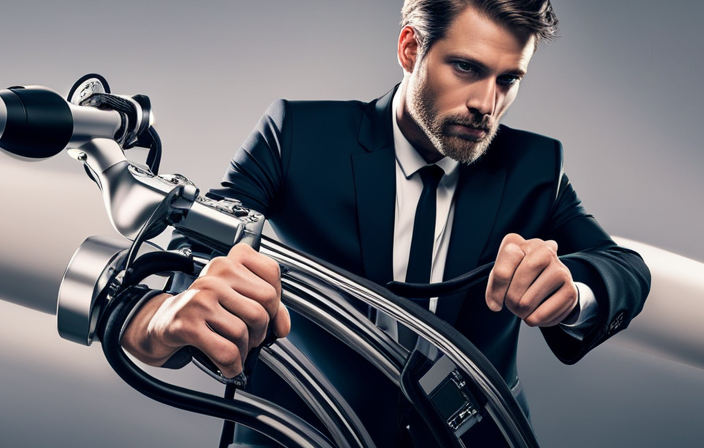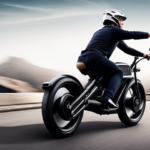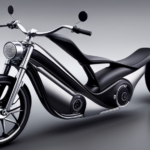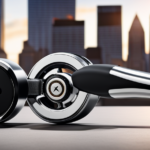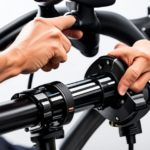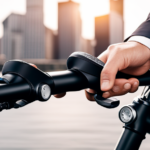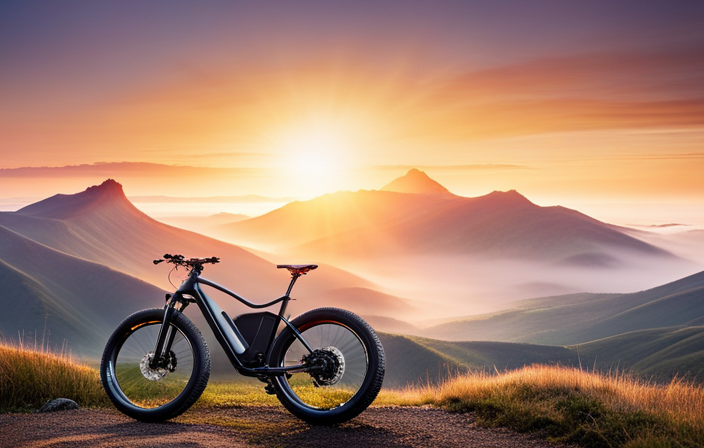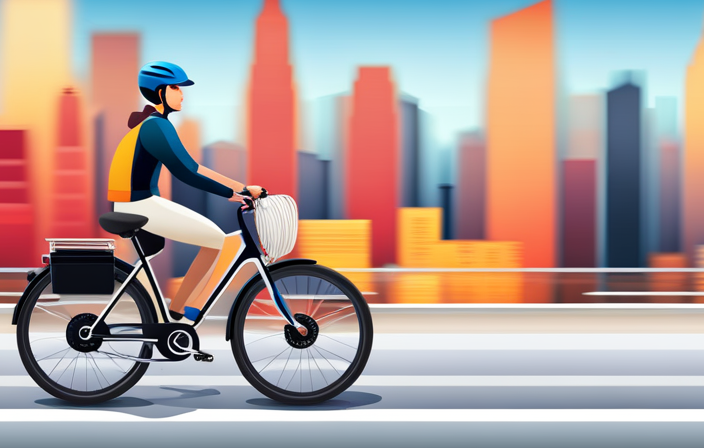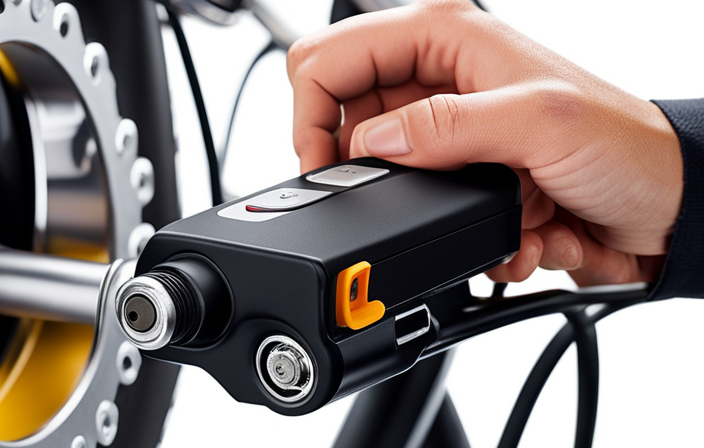Do you ever wonder how an electric bike throttle works? Well, get ready to dive into the fascinating world of throttle control.
In this article, we will explore the mechanics behind a bike throttle, its operation, and the different types of throttle systems available.
You’ll also learn about battery and power management, as well as maintenance and troubleshooting tips.
By the end, you’ll have a clear understanding of the power and convenience that electric bike throttles bring to your rides.
So let’s get started!
Key Takeaways
- The throttle controls the speed of the electric bike with a twist of the handle, similar to a motorcycle.
- The throttle provides instant acceleration without the need to pedal and allows for full control over the speed.
- The throttle sends a signal to the motor controller to adjust the power output of the motor.
- The throttle is particularly beneficial for riders with limited mobility or those needing extra power, as it allows for convenient and effortless navigation through various terrains.
Introduction to Electric Bike Throttles
An electric bike throttle is a device that allows you, as the rider, to effortlessly control the speed of your bike by simply twisting your hand. This ingenious mechanism consists of a twist grip connected to the handlebars, which is then connected to the motor controller.
When you twist the throttle, it sends a signal to the motor controller, telling it to increase or decrease the power sent to the electric motor. This, in turn, adjusts the speed of the bike accordingly.
Understanding throttle control is essential for a smooth and enjoyable riding experience. By mastering the art of throttle control, you can effortlessly accelerate, decelerate, and maintain a consistent speed, allowing you to navigate various terrains and traffic conditions with ease.
Understanding Throttle Control
When it comes to understanding throttle control on electric bikes, it’s crucial to know how throttles are connected to the motor and how they enable variable speed control.
The throttle is directly connected to the motor controller, which regulates the power output based on your input.
How Throttles are Connected to the Motor
To connect the throttle to the motor, you simply twist the handlebar grip. This action engages the throttle mechanism, which then sends a signal to the motor to increase or decrease its power output.
The throttle is connected to the motor through a series of electrical wires and sensors, ensuring a seamless and responsive control system. As you twist the grip, the throttle sends a signal to the motor controller, which interprets the input and adjusts the power accordingly. This allows you to easily control the speed of the electric bike by adjusting the throttle position.
However, the throttle is just one part of the equation. The next section will explain the importance of variable speed control in achieving a smooth and efficient ride.
Variable Speed Control
You can achieve a smooth and efficient ride by utilizing variable speed control. This feature allows you to adjust the speed of your electric bike according to your needs and preferences.
With variable speed control, you have the ability to increase or decrease the speed gradually, providing you with optimal control over your ride. By simply adjusting the throttle, you can smoothly accelerate or decelerate, ensuring a comfortable and enjoyable experience.
This feature is especially useful when navigating through traffic or maneuvering tight corners. It allows you to maintain a steady pace without sudden jerks or lurches.
Now, let’s delve into the mechanics of a bike throttle and understand how it works to give you this precise control over your electric bike’s speed.
Mechanics of a Bike Throttle
The bike throttle controls the speed of an electric bike by adjusting the flow of power from the motor. When you twist the throttle grip, a signal is sent to the motor controller, instructing it to increase or decrease the power output.
Inside the throttle assembly, there is a potentiometer or a Hall effect sensor that detects the position of the throttle grip. This information is then translated into an electrical signal, which is sent to the motor controller. The controller then adjusts the amount of current flowing to the motor, resulting in a corresponding change in speed.
By manipulating the throttle, you have precise control over the acceleration and deceleration of your electric bike, allowing you to easily adapt to different riding conditions.
Now, let’s explore the workings of throttle operation.
Throttle Operation
When twisting the throttle grip, a signal is sent to the motor controller, instructing it to adjust the power output. This simple action is what makes an electric bike throttle work.
The throttle is a crucial component that allows you to control the speed and acceleration of your electric bike. Here are three key aspects that make the throttle operation an exhilarating experience:
-
Instant Power: With just a twist of your wrist, you can unleash the full potential of your electric bike and feel the immediate surge of power.
-
Precise Control: The throttle allows you to finely tune the power output, giving you the ability to navigate through different terrains and adapt to varying riding conditions.
-
Responsive Performance: The electric bike throttle responds swiftly to your commands, providing a seamless and exhilarating riding experience.
Now, let’s delve into the different types of throttle systems used in electric bikes.
Types of Throttle Systems
To understand the different types of throttle systems, it’s important to explore their functionality and benefits.
Electric bikes typically use one of three types of throttle systems: thumb throttles, twist throttles, or pedal-assist throttles.
Thumb throttles are mounted on the handlebars and are pressed with your thumb to control the speed.
Twist throttles, on the other hand, are twisted like a motorcycle throttle to increase or decrease the speed.
Pedal-assist throttles are designed to work in conjunction with your pedaling, providing assistance when needed.
Each type of throttle system has its own advantages and disadvantages. Thumb throttles are easy to use and offer precise control, while twist throttles provide a more intuitive experience. Pedal-assist throttles promote a more active style of riding.
Now that you understand the different types of throttle systems, let’s discuss some safety considerations to keep in mind while operating an electric bike.
Safety Considerations
Be aware of your surroundings and always wear a helmet when operating an electric bike. Safety should be your top priority.
Electric bikes can reach higher speeds than traditional bicycles, so it is important to take precautions. When riding, maintain a safe distance from other vehicles and pedestrians. Always follow traffic rules and signals to ensure your safety and the safety of others.
In addition, make sure to regularly check the brakes, tire pressure, and other components of your electric bike to ensure they are in good working condition.
By being attentive and cautious, you can enjoy a safe and enjoyable ride.
Now, let’s move on to the next section about battery and power management.
Battery and Power Management
Make sure you keep an eye on your battery level and manage your power usage effectively. Here are some key points to consider:
- Monitor your battery: Regularly check the battery level to ensure you have enough power for your ride.
- Optimize your power usage: Use the appropriate assist level based on your riding conditions to conserve battery power.
- Avoid high power-consuming features: Minimize the use of power-hungry features like the throttle to extend your battery life.
- Charge your battery properly: Follow the manufacturer’s guidelines for charging your battery to maintain its health and longevity.
By actively managing your battery and power usage, you can maximize the performance and lifespan of your electric bike.
Now, let’s delve into maintenance and troubleshooting to keep your bike running smoothly.
Maintenance and Troubleshooting
When it comes to maintaining your electric bike, it’s important to pay attention to the throttle. Cleaning and lubricating the throttle regularly is crucial to ensure its smooth operation.
In this discussion, we will explore common throttle issues and provide solutions to keep your electric bike running smoothly.
Cleaning and Lubricating the Throttle
To ensure smooth operation, it’s important to regularly clean and lubricate the electric bike throttle. The throttle is a crucial component that controls the speed and acceleration of your electric bike. Over time, dirt, dust, and debris can accumulate, causing the throttle to become sticky or unresponsive. By following a simple cleaning and lubrication routine, you can keep your throttle in optimal condition.
Here is a step-by-step guide to cleaning and lubricating your electric bike throttle:
| Step | Action |
|---|---|
| 1 | Disconnect the throttle from the electric bike. |
| 2 | Use a soft cloth or brush to remove any visible dirt or debris. |
| 3 | Apply a small amount of electrical contact cleaner to a cloth or q-tip. |
| 4 | Gently clean the throttle housing and the throttle mechanism. |
| 5 | Allow the throttle to dry completely before reconnecting it to the electric bike. |
| 6 | Apply a few drops of lubricant to the moving parts of the throttle mechanism. |
| 7 | Reconnect the throttle and test its functionality. |
Common Throttle Issues and Solutions
Now that you’ve learned how to clean and lubricate the throttle on your electric bike, let’s discuss some common issues that may arise and their solutions.
Understanding these problems will help you maintain your throttle’s functionality and enjoy a smooth riding experience. Here are four common throttle issues and their corresponding solutions:
-
Intermittent response: If the throttle doesn’t consistently respond when you twist it, check the connections between the throttle and the controller. Make sure they are secure and free from damage or corrosion.
-
Sticky throttle: When the throttle becomes sticky or hard to twist, it’s often due to dirt or debris accumulation. Cleaning the throttle with a mild detergent and lubricating it with a silicone-based lubricant can resolve this issue.
-
Unresponsive throttle: If the throttle fails to respond at all, it could indicate a faulty throttle or a problem with the controller. In this case, it’s best to consult a professional to diagnose and repair the issue.
-
Inconsistent speed control: When the electric bike’s speed fluctuates while using the throttle, it could signify an issue with the throttle’s wiring or the controller. Inspect the wiring for any signs of damage and ensure proper connections.
By addressing these common issues promptly, you can ensure the optimal performance of your electric bike’s throttle system.
Now, let’s explore the difference between throttle and pedal assist systems.
Transitioning to the subsequent section about "throttle vs pedal assist," it’s important to understand the key distinctions between these two systems.
Throttle vs Pedal Assist
If you’re considering an electric bike, you’ll want to know the difference between using a throttle and relying on pedal assist. A throttle allows you to control your bike’s speed with a simple twist of the handle, similar to a motorcycle. On the other hand, pedal assist provides a boost to your pedaling efforts, making it easier to ride uphill or maintain a higher speed. To better understand the key differences between these two options, take a look at the table below:
| Throttle | Pedal Assist |
|---|---|
| Instant acceleration | Boosts your pedaling |
| No pedaling required | Requires pedaling |
| Full control over speed | Enhances your efforts |
Now that you understand the distinction between throttle and pedal assist, you can make an informed decision about which option suits your riding style and preferences. In the next section, we will explore the benefits of embracing the power of electric bike throttles.
Conclusion: Embracing the Power of Electric Bike Throttles
Understanding the key differences between throttle and pedal assist options can help you make an informed decision about which option suits your riding style and preferences.
When it comes to electric bike throttles, they provide you with complete control over the motor power output. By simply twisting the throttle, you can increase or decrease the speed of your electric bike without having to pedal. This feature is particularly useful for riders who may have limited mobility, or for situations where you need an extra boost of power, such as going uphill or starting from a standstill.
The throttle operates by sending a signal to the motor controller, which then adjusts the power delivered to the motor. It offers a convenient and effortless way to navigate through various terrains, giving you the freedom to enjoy your ride with ease.
Conclusion
So there you have it, the power of electric bike throttles explained.
Now that you understand how they work, you can fully appreciate the convenience and control they offer. With a simple twist of your wrist, you can effortlessly accelerate and maintain speed on your electric bike.
Whether you prefer a thumb throttle or a twist grip throttle, both options give you the power to effortlessly glide through your rides.
So embrace the power of electric bike throttles and experience the thrill of effortless riding.
Happy biking!
